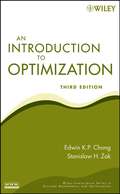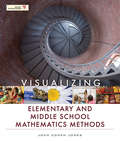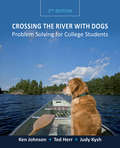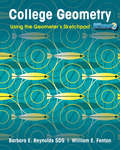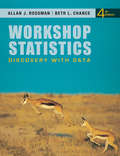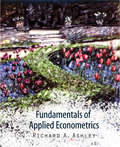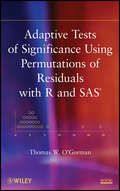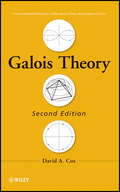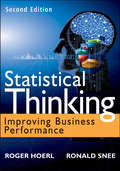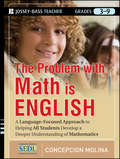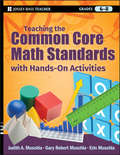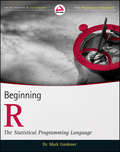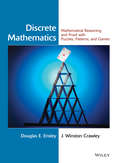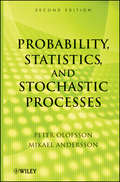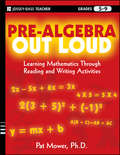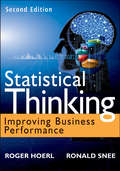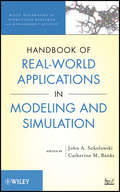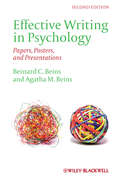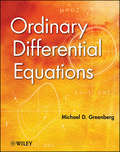- Table View
- List View
An Introduction to Optimization (Wiley Series in Discrete Mathematics and Optimization #72)
by Edwin K. Chong Stanislaw H. ZakPraise from the Second Edition "...an excellent introduction to optimization theory..." (Journal of Mathematical Psychology, 2002) "A textbook for a one-semester course on optimization theory and methods at the senior undergraduate or beginning graduate level." (SciTech Book News, Vol. 26, No. 2, June 2002) Explore the latest applications of optimization theory and methods Optimization is central to any problem involving decision making in many disciplines, such as engineering, mathematics, statistics, economics, and computer science. Now, more than ever, it is increasingly vital to have a firm grasp of the topic due to the rapid progress in computer technology, including the development and availability of user-friendly software, high-speed and parallel processors, and networks. Fully updated to reflect modern developments in the field, An Introduction to Optimization, Third Edition fills the need for an accessible, yet rigorous, introduction to optimization theory and methods. The book begins with a review of basic definitions and notations and also provides the related fundamental background of linear algebra, geometry, and calculus. With this foundation, the authors explore the essential topics of unconstrained optimization problems, linear programming problems, and nonlinear constrained optimization. An optimization perspective on global search methods is featured and includes discussions on genetic algorithms, particle swarm optimization, and the simulated annealing algorithm. In addition, the book includes an elementary introduction to artificial neural networks, convex optimization, and multi-objective optimization, all of which are of tremendous interest to students, researchers, and practitioners. Additional features of the Third Edition include: New discussions of semidefinite programming and Lagrangian algorithms A new chapter on global search methods A new chapter on multipleobjective optimization New and modified examples and exercises in each chapter as well as an updated bibliography containing new references An updated Instructor's Manual with fully worked-out solutions to the exercises Numerous diagrams and figures found throughout the text complement the written presentation of key concepts, and each chapter is followed by MATLAB exercises and drill problems that reinforce the discussed theory and algorithms. With innovative coverage and a straightforward approach, An Introduction to Optimization, Third Edition is an excellent book for courses in optimization theory and methods at the upper-undergraduate and graduate levels. It also serves as a useful, self-contained reference for researchers and professionals in a wide array of fields.
Visualizing Elementary and Middle School Mathematics Methods (Visualizing Series)
by Joan Cohen JonesThe goal of Visualizing Elementary and Middle School Mathematics Methods is to teach mathematics in a way that excites and motivates readers, with an accessible format that serves as an introduction to the teaching of mathematics. This text, in partnership with National Geographic, is designed to present mathematics content and pedagogy in a fresh new way. This unique approach, while maintaining necessary rigor, provides the opportunity to set aside previous beliefs about mathematics and to learn concepts and pedagogy from a new perspective. The structure of Visualizing Elementary and Middle School Mathematics Methods is similar to the format of other methods texts, however, it has many unique features that are designed to be engaging and make the text relevant for readers. It begins with a brief summary of the history of mathematics. Diversity is integrated into the content of every chapter, through Multicultural Perspectives in Mathematics. Several chapters include Virtual Classroom Observation Videos.
Crossing the River with Dogs: Problem Solving for College Students
by Judy Kysh Ken Johnson Ted HerrCrossing the River with Dogs: Problem Solving for College Students, 2nd edition promotes the philosophy that students learn best by working in groups and the skills required for real workplace problem solving are those skills of collaboration. The text aims to improve students writing, oral communication, and collaboration skills while teaching mathematical problem-solving strategies. Focusing entirely on problem solving and using issues relevant to college students for examples, the authors continue their approach of explaining classic as well as non-traditional strategies through dialogs among fictitious students. This text is appropriate for a problem solving, quantitative reasoning, liberal arts mathematics, mathematics for elementary teachers, or developmental mathematics course.
College Geometry: Using the Geometer's Sketchpad
by Barbara E. Reynolds William E. FentonFrom two authors who embrace technology in the classroom and value the role of collaborative learning comes College Geometry Using The Geometer's Sketchpad, a book that is ideal for geometry courses for both mathematics and math education majors. The book's truly discovery-based approach guides students to learn geometry through explorations of topics ranging from triangles and circles to transformational, taxicab, and hyperbolic geometries. In the process, students hone their understanding of geometry and their ability to write rigorous mathematical proofs.
Workshop Statistics: Discovery with Data
by Allan J. Rossman Beth L. ChanceAllan Rossman's 4th Edition of Workshop Statistics: Discovery with Data is enhanced from previous issues with more focus and emphasis on collaborative learning. It further requires student observation, and integrates technology for gathering, recording, and synthesizing data. The text offers more flexibility in selecting technology tools for classrooms primarily using technologies other than graphing calculators or Fathom Dynamic Data software. Furthermore, it presents more standards for teaching statistics in an innovative, investigative, and accessible as well as provides in-depth guidance and resources to support active learning of statistics and includes updated real data sets with everyday applications in order to promote statistical literacy.
Fundamentals of Applied Econometrics
by Richard A. AshleyFundamentals of Applied Econometrics is designed for an applied, undergraduate econometrics course providing students with an understanding of the most fundamental econometric ideas and tools. The text serves both the student whose interest is in understanding how one can use sample data to illuminate economic theory and the student who wants and needs a solid intellectual foundation on which to build practical experiential expertise. Divided into two parts, the first half provides a thorough undergraduate-level treatment of multiple regressions including an extensive statistics review with integrated, hands-on Acting Learning Exercises so students learn by doing. The second half of the book covers a number of advanced topics: panel data modeling, time series analysis, binary-choice modeling, and an introduction to GMM. This latter portion of the book is very suitable for a more advanced course: a second-term undergraduate course, a Masters level course, or as a companion reading for a Doctoral level course.
Adaptive Tests of Significance Using Permutations of Residuals with R and SAS
by Thomas W. O'GormanProvides the tools needed to successfully perform adaptive tests across a broad range of datasets Adaptive Tests of Significance Using Permutations of Residuals with R and SAS illustrates the power of adaptive tests and showcases their ability to adjust the testing method to suit a particular set of data. The book utilizes state-of-the-art software to demonstrate the practicality and benefits for data analysis in various fields of study. Beginning with an introduction, the book moves on to explore the underlying concepts of adaptive tests, including: Smoothing methods and normalizing transformations Permutation tests with linear methods Applications of adaptive tests Multicenter and cross-over trials Analysis of repeated measures data Adaptive confidence intervals and estimates Throughout the book, numerous figures illustrate the key differences among traditional tests, nonparametric tests, and adaptive tests. R and SAS software packages are used to perform the discussed techniques, and the accompanying datasets are available on the book's related website. In addition, exercises at the end of most chapters enable readers to analyze the presented datasets by putting new concepts into practice. Adaptive Tests of Significance Using Permutations of Residuals with R and SAS is an insightful reference for professionals and researchers working with statistical methods across a variety of fields including the biosciences, pharmacology, and business. The book also serves as a valuable supplement for courses on regression analysis and adaptive analysis at the upper-undergraduate and graduate levels.
Galois Theory (Pure and Applied Mathematics: A Wiley Series of Texts, Monographs and Tracts #106)
by David A. CoxPraise for the First Edition ". . .will certainly fascinate anyone interested in abstract algebra: a remarkable book!" —Monatshefte fur Mathematik Galois theory is one of the most established topics in mathematics, with historical roots that led to the development of many central concepts in modern algebra, including groups and fields. Covering classic applications of the theory, such as solvability by radicals, geometric constructions, and finite fields, Galois Theory, Second Edition delves into novel topics like Abel’s theory of Abelian equations, casus irreducibili, and the Galois theory of origami. In addition, this book features detailed treatments of several topics not covered in standard texts on Galois theory, including: The contributions of Lagrange, Galois, and Kronecker How to compute Galois groups Galois's results about irreducible polynomials of prime or prime-squared degree Abel's theorem about geometric constructions on the lemniscates Galois groups of quartic polynomials in all characteristics Throughout the book, intriguing Mathematical Notes and Historical Notes sections clarify the discussed ideas and the historical context; numerous exercises and examples use Maple and Mathematica to showcase the computations related to Galois theory; and extensive references have been added to provide readers with additional resources for further study. Galois Theory, Second Edition is an excellent book for courses on abstract algebra at the upper-undergraduate and graduate levels. The book also serves as an interesting reference for anyone with a general interest in Galois theory and its contributions to the field of mathematics.
Statistical Thinking: Improving Business Performance (Wiley and SAS Business Series #54)
by Roger Hoerl Ron D. SneeHow statistical thinking and methodology can help you make crucial business decisions Straightforward and insightful, Statistical Thinking: Improving Business Performance, Second Edition, prepares you for business leadership by developing your capacity to apply statistical thinking to improve business processes. Unique and compelling, this book shows you how to derive actionable conclusions from data analysis, solve real problems, and improve real processes. Here, you'll discover how to implement statistical thinking and methodology in your work to improve business performance. Explores why statistical thinking is necessary and helpful Provides case studies that illustrate how to integrate several statistical tools into the decision-making process Facilitates and encourages an experiential learning environment to enable you to apply material to actual problems With an in-depth discussion of JMP® software, the new edition of this important book focuses on skills to improve business processes, including collecting data appropriate for a specified purpose, recognizing limitations in existing data, and understanding the limitations of statistical analyses.
The Problem with Math Is English: A Language-Focused Approach to Helping All Students Develop a Deeper Understanding of Mathematics
by Concepcion MolinaTeaching K-12 math becomes an easier task when everyone understands the language, symbolism, and representation of math concepts Published in partnership with SEDL, The Problem with Math Is English illustrates how students often understand fundamental mathematical concepts at a superficial level. Written to inspire ?aha? moments, this book enables teachers to help students identify and comprehend the nuances and true meaning of math concepts by exploring them through the lenses of language and symbolism, delving into such essential topics as multiplication, division, fractions, place value, proportional reasoning, graphs, slope, order of operations, and the distributive property. Offers a new way to approach teaching math content in a way that will improve how all students, and especially English language learners, understand math Emphasizes major attributes of conceptual understanding in mathematics, including simple yet deep definitions of key terms, connections among key topics, and insightful interpretation This important new book fills a gap in math education by illustrating how a deeper knowledge of math concepts can be developed in all students through a focus on language and symbolism.
Teaching the Common Core Math Standards with Hands-On Activities, Grades 6-8
by Judith A. Muschla Gary Robert Muschla Erin MuschlaHelpful advice for teaching Common Core Math Standards to middle-school students The new Common Core State Standards for Mathematics have been formulated to provide students with instruction that will help them acquire a thorough knowledge of math at their grade level, which will in turn enable them to move on to higher mathematics with competence and confidence. Hands-on Activities for Teaching the Common Core Math Standards is designed to help teachers instruct their students so that they will better understand and apply the skills outlined in the Standards. This important resource also gives teachers a wealth of tools and activities that can encourage students to think critically, use mathematical reasoning, and employ various problem-solving strategies. Filled with activities that will help students gain an understanding of math concepts and skills correlated to the Common Core State Math Standards Offers guidance for helping students apply their understanding of math concepts and skills, develop proficiency in calculations, and learn to think abstractly Describes ways to get students to collaborate with other students, utilize technology, communicate ideas about math both orally and in writing, and gain an appreciation of the significance of mathematics to real life This practical and easy-to-use resource will help teachers give students the foundation they need for success in higher mathematics.
Beginning R: The Statistical Programming Language
by Mark GardenerConquer the complexities of this open source statistical language R is fast becoming the de facto standard for statistical computing and analysis in science, business, engineering, and related fields. This book examines this complex language using simple statistical examples, showing how R operates in a user-friendly context. Both students and workers in fields that require extensive statistical analysis will find this book helpful as they learn to use R for simple summary statistics, hypothesis testing, creating graphs, regression, and much more. It covers formula notation, complex statistics, manipulating data and extracting components, and rudimentary programming. R, the open source statistical language increasingly used to handle statistics and produces publication-quality graphs, is notoriously complex This book makes R easier to understand through the use of simple statistical examples, teaching the necessary elements in the context in which R is actually used Covers getting started with R and using it for simple summary statistics, hypothesis testing, and graphs Shows how to use R for formula notation, complex statistics, manipulating data, extracting components, and regression Provides beginning programming instruction for those who want to write their own scripts Beginning R offers anyone who needs to perform statistical analysis the information necessary to use R with confidence.
Discrete Mathematics: Mathematical Reasoning and Proof with Puzzles, Patterns, and Games
by Douglas E. Ensley J. Winston CrawleyDid you know that games and puzzles have given birth to many of today's deepest mathematical subjects? Now, with Douglas Ensley and Winston Crawley's Introduction to Discrete Mathematics, you can explore mathematical writing, abstract structures, counting, discrete probability, and graph theory, through games, puzzles, patterns, magic tricks, and real-world problems. You will discover how new mathematical topics can be applied to everyday situations, learn how to work with proofs, and develop your problem-solving skills along the way. Online applications help improve your mathematical reasoning. Highly intriguing, interactive Flash-based applications illustrate key mathematical concepts and help you develop your ability to reason mathematically, solve problems, and work with proofs. Explore More icons in the text direct you to online activities at www.wiley.com/college/ensley. Improve your grade with the Student Solutions Manual. A supplementary Student Solutions Manual contains more detailed solutions to selected exercises in the text.
Probability, Statistics, and Stochastic Processes
by Peter Olofsson Mikael AnderssonPraise for the First Edition ". . . an excellent textbook . . . well organized and neatly written." —Mathematical Reviews ". . . amazingly interesting . . ." —Technometrics Thoroughly updated to showcase the interrelationships between probability, statistics, and stochastic processes, Probability, Statistics, and Stochastic Processes, Second Edition prepares readers to collect, analyze, and characterize data in their chosen fields. Beginning with three chapters that develop probability theory and introduce the axioms of probability, random variables, and joint distributions, the book goes on to present limit theorems and simulation. The authors combine a rigorous, calculus-based development of theory with an intuitive approach that appeals to readers' sense of reason and logic. Including more than 400 examples that help illustrate concepts and theory, the Second Edition features new material on statistical inference and a wealth of newly added topics, including: Consistency of point estimators Large sample theory Bootstrap simulation Multiple hypothesis testing Fisher's exact test and Kolmogorov-Smirnov test Martingales, renewal processes, and Brownian motion One-way analysis of variance and the general linear model Extensively class-tested to ensure an accessible presentation, Probability, Statistics, and Stochastic Processes, Second Edition is an excellent book for courses on probability and statistics at the upper-undergraduate level. The book is also an ideal resource for scientists and engineers in the fields of statistics, mathematics, industrial management, and engineering.
Probability, Statistics, and Stochastic Processes
by Peter Olofsson Mikael AnderssonPraise for the First Edition ". . . an excellent textbook . . . well organized and neatly written." —Mathematical Reviews ". . . amazingly interesting . . ." —Technometrics Thoroughly updated to showcase the interrelationships between probability, statistics, and stochastic processes, Probability, Statistics, and Stochastic Processes, Second Edition prepares readers to collect, analyze, and characterize data in their chosen fields. Beginning with three chapters that develop probability theory and introduce the axioms of probability, random variables, and joint distributions, the book goes on to present limit theorems and simulation. The authors combine a rigorous, calculus-based development of theory with an intuitive approach that appeals to readers' sense of reason and logic. Including more than 400 examples that help illustrate concepts and theory, the Second Edition features new material on statistical inference and a wealth of newly added topics, including: Consistency of point estimators Large sample theory Bootstrap simulation Multiple hypothesis testing Fisher's exact test and Kolmogorov-Smirnov test Martingales, renewal processes, and Brownian motion One-way analysis of variance and the general linear model Extensively class-tested to ensure an accessible presentation, Probability, Statistics, and Stochastic Processes, Second Edition is an excellent book for courses on probability and statistics at the upper-undergraduate level. The book is also an ideal resource for scientists and engineers in the fields of statistics, mathematics, industrial management, and engineering.
Pre-Algebra Out Loud: Learning Mathematics Through Reading and Writing Activities
by Pat MowerAn essential guide for teaching students in grades 5-9 how to write about math Learning to read and write efficiently regarding mathematics helps students to understand content at a deeper level. In this third book in the popular math 'Out Loud' series, Mower provides a variety of reading and writing strategies and activities suitable for elementary and middle school pre-algebra courses, covering such key skills as integers and exponents, fractions, decimals and percents, graphing, statistics, factoring, evaluating expressions, geometry and the basics of equations. Includes dozens of classroom tested strategies and techniques Shows how reading and writing can be incorporated in any math class to improve math skills Provides unique, fun activities that will keep students interested and make learning stick This important guide offers teachers easy-to-apply lessons that will help students develop a deeper understanding of mathematics.
Statistical Thinking: Improving Business Performance (Wiley and SAS Business Series #58)
by Roger Hoerl Ron D. SneeHow statistical thinking and methodology can help you make crucial business decisions Straightforward and insightful, Statistical Thinking: Improving Business Performance, Second Edition, prepares you for business leadership by developing your capacity to apply statistical thinking to improve business processes. Unique and compelling, this book shows you how to derive actionable conclusions from data analysis, solve real problems, and improve real processes. Here, you'll discover how to implement statistical thinking and methodology in your work to improve business performance. Explores why statistical thinking is necessary and helpful Provides case studies that illustrate how to integrate several statistical tools into the decision-making process Facilitates and encourages an experiential learning environment to enable you to apply material to actual problems With an in-depth discussion of JMP® software, the new edition of this important book focuses on skills to improve business processes, including collecting data appropriate for a specified purpose, recognizing limitations in existing data, and understanding the limitations of statistical analyses.
The Problem with Math Is English: A Language-Focused Approach to Helping All Students Develop a Deeper Understanding of Mathematics
by Concepcion MolinaTeaching K-12 math becomes an easier task when everyone understands the language, symbolism, and representation of math concepts Published in partnership with SEDL, The Problem with Math Is English illustrates how students often understand fundamental mathematical concepts at a superficial level. Written to inspire ?aha? moments, this book enables teachers to help students identify and comprehend the nuances and true meaning of math concepts by exploring them through the lenses of language and symbolism, delving into such essential topics as multiplication, division, fractions, place value, proportional reasoning, graphs, slope, order of operations, and the distributive property. Offers a new way to approach teaching math content in a way that will improve how all students, and especially English language learners, understand math Emphasizes major attributes of conceptual understanding in mathematics, including simple yet deep definitions of key terms, connections among key topics, and insightful interpretation This important new book fills a gap in math education by illustrating how a deeper knowledge of math concepts can be developed in all students through a focus on language and symbolism.
Teaching the Common Core Math Standards with Hands-On Activities, Grades 6-8
by Judith A. Muschla Gary Robert Muschla Erin MuschlaHelpful advice for teaching Common Core Math Standards to middle-school students The new Common Core State Standards for Mathematics have been formulated to provide students with instruction that will help them acquire a thorough knowledge of math at their grade level, which will in turn enable them to move on to higher mathematics with competence and confidence. Hands-on Activities for Teaching the Common Core Math Standards is designed to help teachers instruct their students so that they will better understand and apply the skills outlined in the Standards. This important resource also gives teachers a wealth of tools and activities that can encourage students to think critically, use mathematical reasoning, and employ various problem-solving strategies. Filled with activities that will help students gain an understanding of math concepts and skills correlated to the Common Core State Math Standards Offers guidance for helping students apply their understanding of math concepts and skills, develop proficiency in calculations, and learn to think abstractly Describes ways to get students to collaborate with other students, utilize technology, communicate ideas about math both orally and in writing, and gain an appreciation of the significance of mathematics to real life This practical and easy-to-use resource will help teachers give students the foundation they need for success in higher mathematics.
Beginning R: The Statistical Programming Language
by Mark GardenerConquer the complexities of this open source statistical language R is fast becoming the de facto standard for statistical computing and analysis in science, business, engineering, and related fields. This book examines this complex language using simple statistical examples, showing how R operates in a user-friendly context. Both students and workers in fields that require extensive statistical analysis will find this book helpful as they learn to use R for simple summary statistics, hypothesis testing, creating graphs, regression, and much more. It covers formula notation, complex statistics, manipulating data and extracting components, and rudimentary programming. R, the open source statistical language increasingly used to handle statistics and produces publication-quality graphs, is notoriously complex This book makes R easier to understand through the use of simple statistical examples, teaching the necessary elements in the context in which R is actually used Covers getting started with R and using it for simple summary statistics, hypothesis testing, and graphs Shows how to use R for formula notation, complex statistics, manipulating data, extracting components, and regression Provides beginning programming instruction for those who want to write their own scripts Beginning R offers anyone who needs to perform statistical analysis the information necessary to use R with confidence.
Handbook of Real-World Applications in Modeling and Simulation (Wiley Series in Operations Research and Management Science #2)
by John A. Sokolowski Catherine M. BanksIntroduces various modeling and simulation methods and paradigms that are used to explain and solve the predominant challenges facing society Handbook of Real-World Applications in Modeling and Simulation provides a thorough explanation of modeling and simulation in the most useful, current, and predominant applied areas of transportation, homeland security, medicine, operational research, military science, and business modeling. Offering a cutting-edge and accessible presentation, this book discusses how and why the presented domains have become leading applications of modeling and simulation techniques. Contributions from leading academics and researchers integrate modeling and simulation theories, methods, and data to analyze challenges that involve technological and social issues. The book begins with an introduction that explains why modeling and simulation is a reliable analysis assessment tool for complex systems problems. Subsequent chapters provide an orientation to various modeling and simulation methods and paradigms that are used to explain and solve the predominant challenges across real-world applied domains. Additionally, the handbook: Provides a practical one-stop reference on modeling and simulation and contains an accessible introduction to key concepts and techniques Introduces, trains, and prepares readers from statistics, mathematics, engineering, computer science, economics, and business to use modeling and simulation in their studies and research Features case studies that are representative of fundamental areas of multidisciplinary studies and provides a concise look at the key concepts of modeling and simulation Contains a collection of original ideas on modeling and simulation to help academics and practitioners develop a multifunctional perspective Self-contained chapters offer a comprehensive approach to explaining each respective domain and include sections that explore the related history, theory, modeling paradigms, and case studies. Key terms and techniques are clearly outlined, and exercise sets allow readers to test their comprehension of the presented material. Handbook of Real-World Applications in Modeling and Simulation is an essential reference for academics and practitioners in the areas of operations research, business, management science, engineering, statistics, mathematics, and computer science. The handbook is also a suitable supplement for courses on modeling and simulation at the graduate level.
Handbook of Real-World Applications in Modeling and Simulation (Wiley Series in Operations Research and Management Science #2)
by John A. Sokolowski Catherine M. BanksIntroduces various modeling and simulation methods and paradigms that are used to explain and solve the predominant challenges facing society Handbook of Real-World Applications in Modeling and Simulation provides a thorough explanation of modeling and simulation in the most useful, current, and predominant applied areas of transportation, homeland security, medicine, operational research, military science, and business modeling. Offering a cutting-edge and accessible presentation, this book discusses how and why the presented domains have become leading applications of modeling and simulation techniques. Contributions from leading academics and researchers integrate modeling and simulation theories, methods, and data to analyze challenges that involve technological and social issues. The book begins with an introduction that explains why modeling and simulation is a reliable analysis assessment tool for complex systems problems. Subsequent chapters provide an orientation to various modeling and simulation methods and paradigms that are used to explain and solve the predominant challenges across real-world applied domains. Additionally, the handbook: Provides a practical one-stop reference on modeling and simulation and contains an accessible introduction to key concepts and techniques Introduces, trains, and prepares readers from statistics, mathematics, engineering, computer science, economics, and business to use modeling and simulation in their studies and research Features case studies that are representative of fundamental areas of multidisciplinary studies and provides a concise look at the key concepts of modeling and simulation Contains a collection of original ideas on modeling and simulation to help academics and practitioners develop a multifunctional perspective Self-contained chapters offer a comprehensive approach to explaining each respective domain and include sections that explore the related history, theory, modeling paradigms, and case studies. Key terms and techniques are clearly outlined, and exercise sets allow readers to test their comprehension of the presented material. Handbook of Real-World Applications in Modeling and Simulation is an essential reference for academics and practitioners in the areas of operations research, business, management science, engineering, statistics, mathematics, and computer science. The handbook is also a suitable supplement for courses on modeling and simulation at the graduate level.
Effective Writing in Psychology: Papers, Posters,and Presentations
by Bernard C. Beins Agatha M. BeinsThe second edition of Effective Writing in Psychology helps users produce crisp scientific communication, form concise unambiguous arguments, and render technical information clear and comprehensible. The new edition incorporates the latest guidelines contained within the 6th edition of the APA Publication Manual. Clear guidelines on effective writing illustrate how to generate strong and compelling prose, even when the writing is not aimed at a research audience Incorporates changes to the guidelines contained in the 6th edition of the APA publication manual Includes material on how to adapt APA style for poster presentations using PowerPoint, and for oral presentations Contains a new section on using the Internet to present research papers and a new chapter on conducting a literature search, to guide students through databases, keywords, sources, and connections between articles Highlights methods for selecting a research topic and organizing papers Features a sample manuscript showing common deviations from correct APA style and a version demonstrating appropriate use of APA style
Effective Writing in Psychology: Papers, Posters,and Presentations (Wiley Desktop Editions Ser.)
by Bernard C. Beins Agatha M. BeinsThe second edition of Effective Writing in Psychology helps users produce crisp scientific communication, form concise unambiguous arguments, and render technical information clear and comprehensible. The new edition incorporates the latest guidelines contained within the 6th edition of the APA Publication Manual. Clear guidelines on effective writing illustrate how to generate strong and compelling prose, even when the writing is not aimed at a research audience Incorporates changes to the guidelines contained in the 6th edition of the APA publication manual Includes material on how to adapt APA style for poster presentations using PowerPoint, and for oral presentations Contains a new section on using the Internet to present research papers and a new chapter on conducting a literature search, to guide students through databases, keywords, sources, and connections between articles Highlights methods for selecting a research topic and organizing papers Features a sample manuscript showing common deviations from correct APA style and a version demonstrating appropriate use of APA style
Ordinary Differential Equations
by Michael D. GreenbergFeatures a balance between theory, proofs, and examples and provides applications across diverse fields of study Ordinary Differential Equations presents a thorough discussion of first-order differential equations and progresses to equations of higher order. The book transitions smoothly from first-order to higher-order equations, allowing readers to develop a complete understanding of the related theory. Featuring diverse and interesting applications from engineering, bioengineering, ecology, and biology, the book anticipates potential difficulties in understanding the various solution steps and provides all the necessary details. Topical coverage includes: First-Order Differential Equations Higher-Order Linear Equations Applications of Higher-Order Linear Equations Systems of Linear Differential Equations Laplace Transform Series Solutions Systems of Nonlinear Differential Equations In addition to plentiful exercises and examples throughout, each chapter concludes with a summary that outlines key concepts and techniques. The book's design allows readers to interact with the content, while hints, cautions, and emphasis are uniquely featured in the margins to further help and engage readers. Written in an accessible style that includes all needed details and steps, Ordinary Differential Equations is an excellent book for courses on the topic at the upper-undergraduate level. The book also serves as a valuable resource for professionals in the fields of engineering, physics, and mathematics who utilize differential equations in their everyday work. An Instructors Manual is available upon request. Email sfriedman@wiley.com for information. There is also a Solutions Manual available. The ISBN is 9781118398999.
